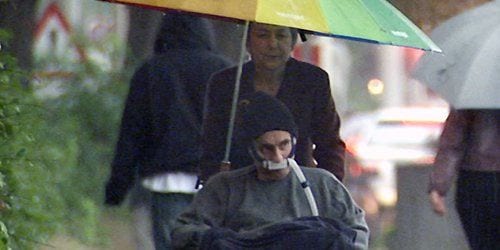
“Are you getting tired of cucumber?” “I’m getting tired of vegetables.”
Mary Ewert is helping her husband Craig to eat. A former professor of computer science now afflicted with ALS (Lou Gherig’s disease), he’s increasingly unable to do things for himself. It’s frustrating, of course, and he depends on Mary. She tends to his every need, physical and emotional. “I probably appear to be rather unmoved, perhaps, people would say,” she says. “I don’t know. But I think the thing is, remember, we’ve been dealing with this for months and months. So that, probably, my worst times were when they were just kind of coming up with the diagnosis. I think having to do the daily care sort of makes to have to be…”
“Stronger?” Craig finishes. Mary goes on, “Yeah. And just, you know, it’s daily life. You have to get on. You either do that or you fall apart. And what good does the latter do?”
The Ewerts are here the subjects of The Suicide Tourist, a documentary by John Zaritzky, originally made in 2007 and currently airing on TV and online as part of PBS’ Frontline series. This means the original film has been cut to fit an hour-or-so format, and includes narration by Will Lyman. He explains over a series of old photos that this “outgoing Irish Catholic girl from a conservative family” and “introverted agnostic” have shared a 37-year marriage, and now face an unexpected end. Hoping to regain some control over the process of Craig’s death, they come to Dignitas, “one of a handful of Swiss groups devoted to helping people end their lives legally.”
Accompanied by Zaritzky’s camera crew, the Chicago-based Ewerts arrive in Zurich, where they spend a few days signing papers and enjoying sunny days in the local park. In their hotel room, Craig contemplates his options, both ending in his death. “I can either actually go through with it or I say I’m too scared, I can’t do it,” he submits. “If I don’t go through with it, my choice is to suffer and inflict suffering on my family and then die, quite possibly in a way that is more painful and more stressful than this way.” Mary stands quietly by his side, her face barely suggesting how difficult these options are for her.
It’s to be expected, that the program focuses on Craig’s situation (the other part of the original film, available on the PBS site, follows a couple from Vancouver as they seek another alternative, as Betty Columbias, fully healthy, wants to die alongside her terminally ill husband George). The Frontline version presents the Americans during Craig’s final days (“In a way,” he says, “it’s kind of like the first day of school, you don’t really know what’s coming up”), as well as explications by Dignitas founder Ludwig Minelli (since 1998, the organization has helped more than 1,000 people die, all from outside Switzerland, a point that makes Dignitas unique). Though opponents argue that Dignitas invites a kind of “suicide tourism,” by which people with means circumvent laws where they live, seeking legal sanction in Switzerland (assisted suicide is legal in some other countries, as well as Oregon and Washington state).
While assisted suicide raises profound questions concerning both risks and benefits, the potential for abuses versus respect for individual rights, needs, and desires, The Suicide Tourist doesn’t engage in these debates. Instead, it observes the Ewerts as they go through this complicated journey. “I’m not tired of living,” Craig sighs. “I’m tired of the disease, but I’m not tired of living. And I still enjoy it enough that I’d like to continue. But the thing is, that I really can’t.” He and Mary understand that he must be the one, legally, to commit the act: he must drink the liquid that will end his life, and agree to be taped so that Swiss authorities can assure themselves that the assistant from Dignitas only assists. The film understandably attends to Craig’s experience, his good humor, sensitivity, and resolve: his final moments are rendered in a series of close-ups and dissolves, under the Beethoven movement he has asked to hear.
Certainly, this scene is affecting. But then the program cuts to Mary, after. Alone in their hotel room, she begins to describe her feelings. “We still had time to talk,” she smiles, “And we talked a lot.” She folds up her husband’s wheelchair in order to pack it into the car that will take her to the airport. The sense of her loneliness is overwhelming. As is her strength.

![Call for Papers: All Things Reconsidered [MUSIC] May-August 2024](https://www.popmatters.com/wp-content/uploads/2024/04/all-things-reconsidered-call-music-may-2024-720x380.jpg)



